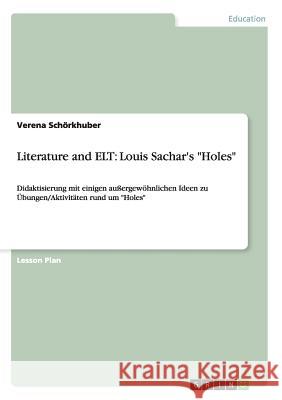Literature and ELT: Louis Sachar's Holes: Didaktisierung mit einigen außergewöhnlichen Ideen zu Übungen/Aktivitäten rund um Holes » książka
Literature and ELT: Louis Sachar's Holes: Didaktisierung mit einigen außergewöhnlichen Ideen zu Übungen/Aktivitäten rund um Holes
ISBN-13: 9783656343738 / Angielski / Miękka / 2013 / 26 str.
Literature and ELT: Louis Sachar's Holes: Didaktisierung mit einigen außergewöhnlichen Ideen zu Übungen/Aktivitäten rund um Holes
ISBN-13: 9783656343738 / Angielski / Miękka / 2013 / 26 str.
(netto: 159,43 VAT: 5%)
Najniższa cena z 30 dni: 156,53 zł
ok. 13-18 dni roboczych
Dostawa przed świętami

Darmowa dostawa!
Lesson Plan from the year 2012 in the subject English - Pedagogy, Didactics, Literature Studies, grade: 1,0, University of Vienna (Institut fur Anglistik und Amerikanistik), course: Literature and ELT (Fachdidaktik-Kurs), language: English, abstract: Bei dieser Arbeit fur den Fachdidaktik-Kurs "Literature and ELT" handelt es sich um eine Didaktiksierung des Abenteuerromans "Holes" von Louis Sachar (ab 4./5. Lernjahr) mit einigen auergewohnlichen Ideen zu Ubungen/Aktivitaten rund um "Holes" (Dauer ca. 4 St.), welche auch auf andere literarische Werke angewandt werden konnen (creating wanted posters, telephone conversations with the author, ...). Inhalt: Introduction: Why teach literature (or Literature?) in ELT; Choice of text; Work plan for four lessons; Conclusion; Bibliography; Appendix/Work sheets: 'dig it', character sketch, 'mad lib', discuss-decide-survive, filling in the holes: questions, create your own 'wanted poster', reading log. Auszug: Choice of text We shouldn't teach great books; we should teach a love of reading. (B. F. Skinner) I have chosen the novel Holes by Louis Sachar with the quotation above in mind: even though it might not be classified as one of the 'great books', i.e. of '(high) Literature', it is definitely one of those books that can serve to 'teach a love of reading'. Holes is the exciting story of Stanley Yelnats (mind the palindrome ), an overweight boy who is unjustly sent to Camp Green Lake, a boys' juvenile detention centre. Stanley knows that this is due to a curse on his 'no-good-dirty-rotten-pig-stealing-great-great-grandfather', who did not fulfil a promise he had made to Madame Zeroni. At the camp, Stanley and six other boys are forced to dig holes every day in order to pay their debt to society. However, Stanley soon finds out that there is more than 'character building' going on ...]. The novel and its main themes (friendship, racism, justice, fate, etc.) can be exploited in many appealing ways for classroom reading











